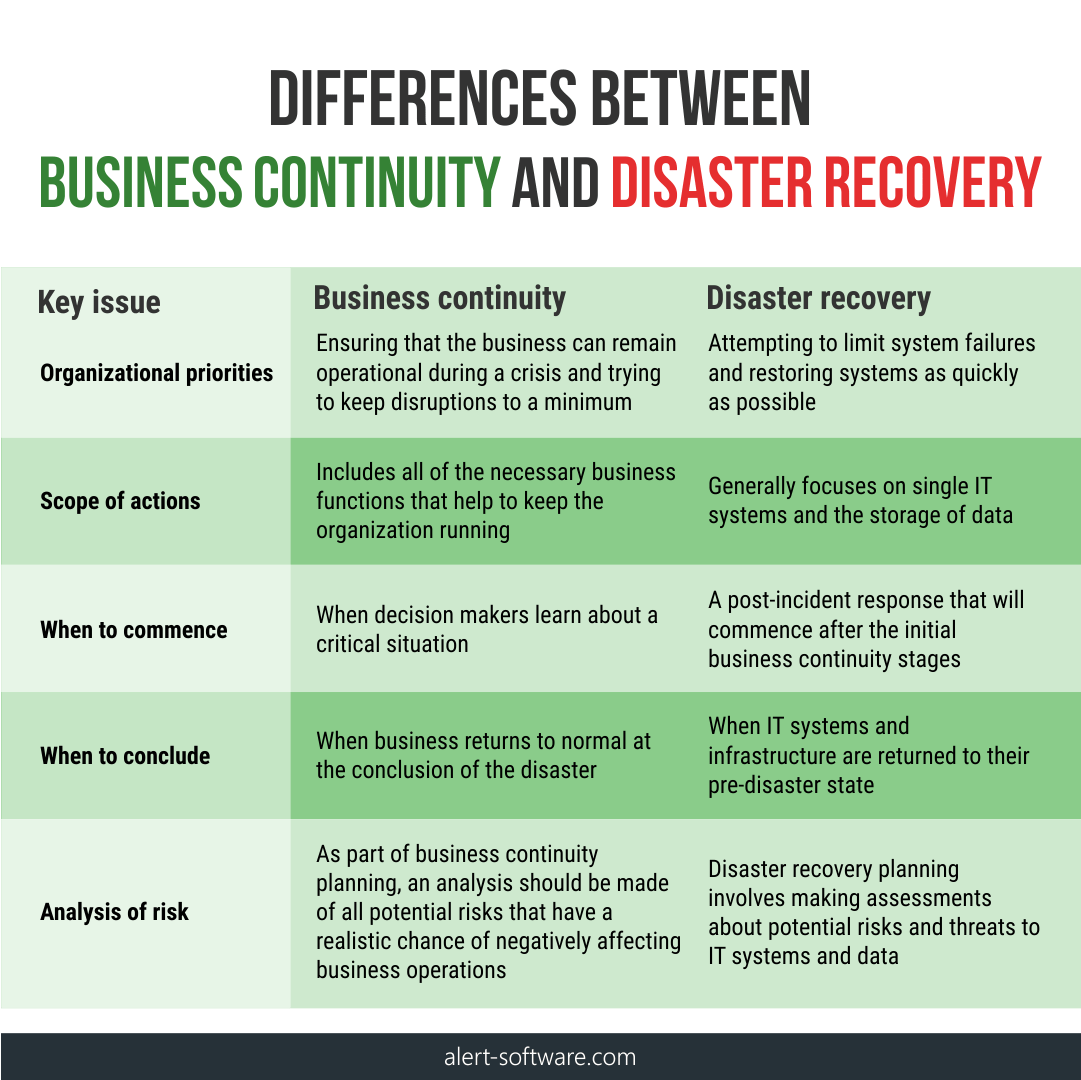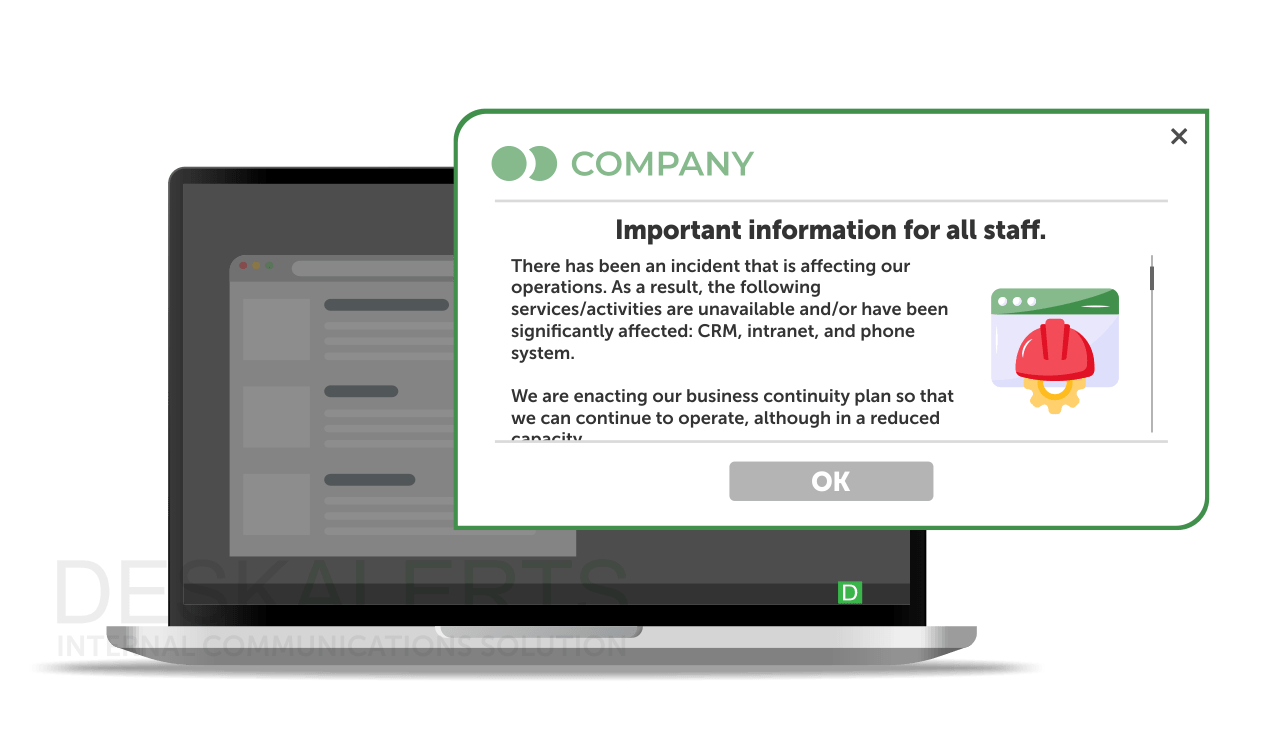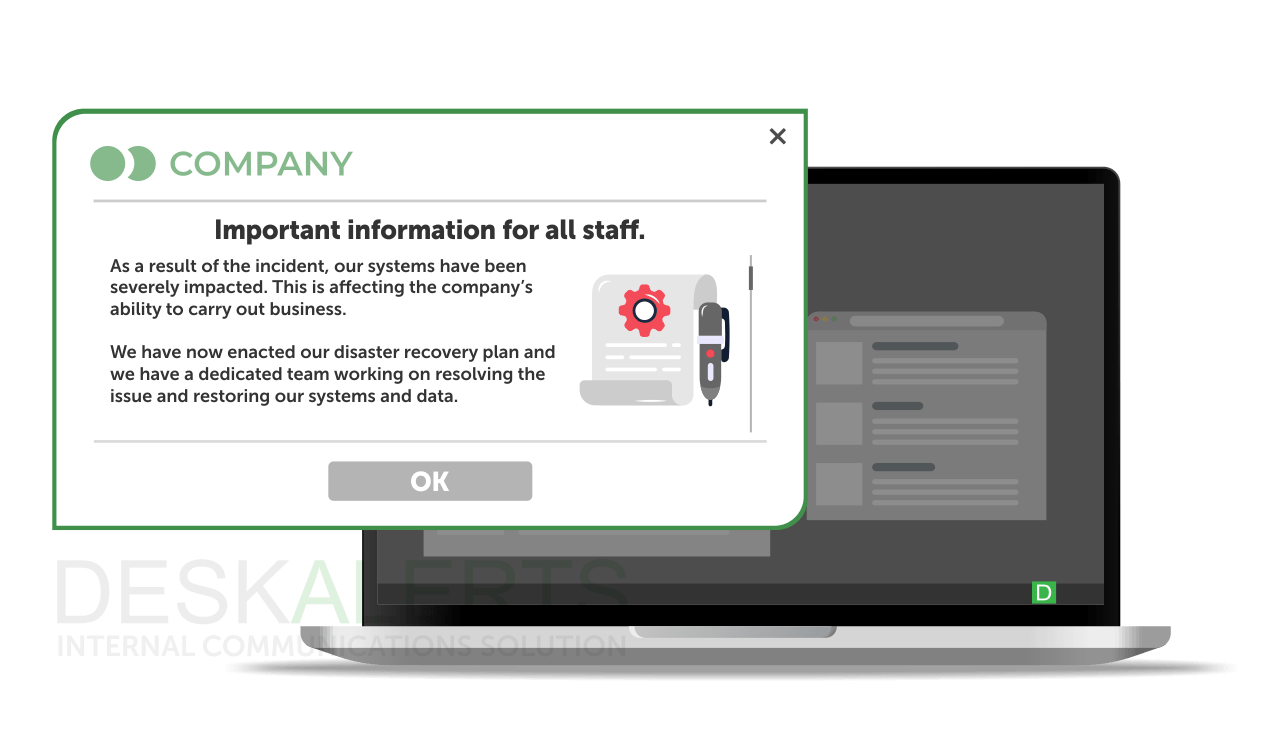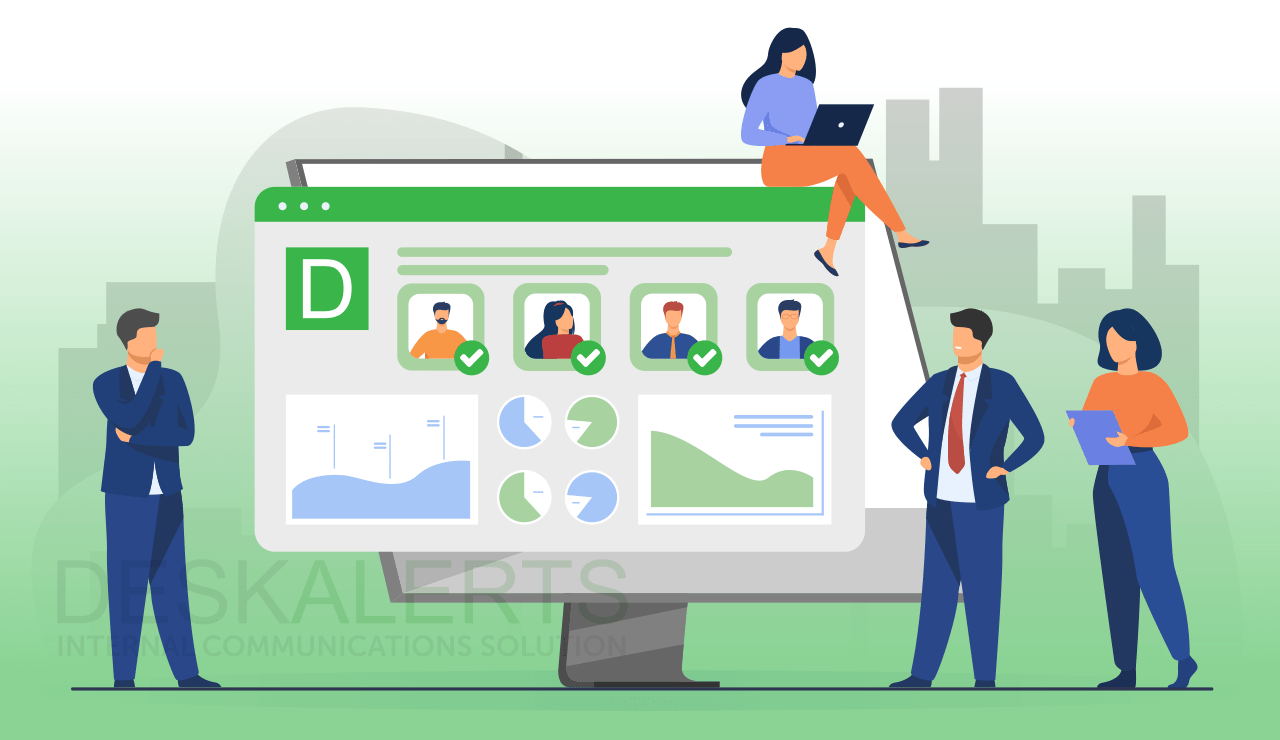
When your company faces a crisis, it is important that you are prepared for both business continuity and disaster recovery so that you can resume your operations as quickly as possible.
Understanding business continuity vs disaster recovery is essential – you shouldn’t get the two confused. Having both a business continuity plan and a disaster recovery plan will help with your organization’s recovery and ongoing viability.
Table of contents
What is business continuity?
5 differences between disaster recovery vs business continuity
Business continuity plan vs disaster recovery plan: do you need both?
What to include in a business continuity plan
4 main components of a successful business continuity management plan
What to include in a disaster recovery plan
The risks of not having business continuity and disaster recovery plans
Why communication is critical in disaster situations
What is business continuity?
The term business continuity is used to describe a business's process to remain operational during and after a disaster. This includes contingency planning for how a company will operate, who will carry out particular roles, where the business will operate from, and what effects this will have on normal business operations.
Read also: Cloud-Based Business COntinuity Needs Communication – Here's Why.

Disaster recovery is a term that describes the plans a company puts into place that it will use to respond to a disaster or other critical event. This can include natural disasters, fire, data loss, cyber-attacks, terrorism, accidents, active shooters and other incidents that have the ability to hamper the business’ operations. Disaster recovery plans help to guide the organization in its response to the incident or event and provide guidance on returning to usual operations safely.
Together, these form an approach called BCDR. BCDR’s meaning is Business Continuity and Disaster Recovery. BCDR is a comprehensive approach to organizational resilience, encompassing strategies and procedures aimed at ensuring the continuity of critical business functions during and after disruptive events.
BCDR strategies help organizations effectively respond to emergencies, protect assets, safeguard data, and ultimately ensure business continuity in the face of adversity, thereby enhancing overall resilience and minimizing the impact of disruptions on operations and stakeholders.

5 differences between disaster recovery and business continuity
What is the difference between business continuity and disaster recovery?
There are some similarities between the two planning processes: they empower a business with proactive strategies to help it prepare for a catastrophic event. However, there are several differences that organizations should be aware of when it comes to business continuity vs disaster recovery:
- Essentially, business continuity is a focus on keeping the business operational while a disaster unfolds and in its immediate aftermath. On the other hand, disaster recovery32 is a focus on restoring processes, systems and IT infrastructure and data following a critical event.
- Disaster recovery plans often involve scenario planning and conducting preparedness drills and other exercises long before there is an actual incident.
- The delivery of a business continuity plan is at a different time from a disaster recovery plan.
- They have different goals: business continuity plans are concerned with limiting downtime, while disaster recovery plans are concerned with ensuring the company doesn’t suffer from inefficient systems functions.
- Business continuity is concerned with functioning in some capacity, albeit possibly reduced. Disaster recovery is concerned with getting back to normal business functions.
Real-life example of business continuity:
Back in 2013, lightning struck the office building of a South Carolina based IT company that hosted servers for 200 clients. The company’s infrastructure was badly affected: cables were melted, computer hardware was burnt, equipment was destroyed and the office couldn’t be used at all.
The company had already implemented business continuity plans five years earlier that included relocating its client servers to a remote data server where continual backups were kept. Clients didn’t experience any issues, and employees had to relocate to temporary office premises for a period of time.
Business continuity vs disaster recovery plans: do you need both?
In order to ensure business continuity or disaster recovery, it is essential to have formal plans in place.
While it is possible to have just one or the other, businesses really should have both disaster recovery plans (DRP) and business continuity plans (BCP) in place to successfully navigate and recover from a disaster. While they are different, they do have some overlap and work well together to help minimize disruption and losses.

What to include in a business continuity plan
When developing a business continuity plan for your organization, you need to consider the following:
- Create a list of all the critical business functions in your organization
- Create a business impact analysis
- Develop a range of different crises scenarios and consider how they could interrupt your business operations
- Develop strategies to mitigate any vulnerabilities you have identified to maintain functionality in a disaster.
- Identify employees who will have key roles in implementing business continuity processes.
- Provide training to relevant employees
- Review and evaluate your business continuity plan regularly.
4 main components of a successful Business Continuity Management Plan
- Policy
- Governance
- Scope
- Roles
The perfect BCM policy for your company will identify the importance of governance in a state of emergency and educate all staff members on why they must adhere to the required protocols.
It is essential to establish who is in charge during each specific emergency, this will help directors to identify the key parties in your business continuity management structure.
Once you know this, you have a platform set in place, also known as your program scope.
The program scope will help you define what business continuity means for your organization.
As a director, you should select a skilled individual or group to handle each issue when and if they arise. Which team is responsible for implementing and enforcing the next steps your company will need to take to get out of a jam?
This is the time to assign roles and responsibilities to members of your staff.
You will need a team for each important aspect of the company, and their job would be to maintain that aspect, such as:
- Products and service availability
- Data accessibility
- Applications running constantly
- The overall safety and privacy of staff members
- Keep revenue-generating components of the company functioning well
The business continuity tools you choose for your company should assist teams in doing their maintenance job well and with the least bit of disruptions.
What to include in a disaster recovery plan
The disaster recovery plan has some similar requirements and features to the business continuity plan. When developing one, you need to consider the following:
- Identify people in your organization who should form a disaster recovery team.
- Identify the critical processes and functions that could be affected by a disaster.
- Identify potential disaster risks and consider how they could affect your business operations.
- Design disaster recovery strategies and processes.
- Devise back-up plans and procedures.
- Ensure your employees are trained.
- Test and maintain your plan on a regular basis.
The risks of not having business continuity and disaster recovery plans
Failing to be prepared for a critical situation or a disaster can have significant consequences for a business if it is caught out without appropriate business continuity and disaster recovery plans.
This can include:
- The inability for the business to function following a crisis
- Reduction in productivity following a crisis
- Financial losses
- Reputational damage
- Potential legal consequences, particularly if failure to plan and protect data results in regulatory violations
- Death or injury to employees, customers, the public etc.
- Complete data loss.

The Role of Business Continuity Planning Software
In today’s fast-evolving business landscape, maintaining operations during disruptions is no longer optional—it’s essential. This is where business continuity planning software becomes an invaluable asset. It streamlines the process of creating, implementing, and managing a comprehensive business continuity strategy, ensuring your organization remains resilient in the face of challenges.
Why Use Business Continuity Planning Software?
-
Streamlined Planning Process:
Traditional manual planning can be time-consuming and prone to errors. With business continuity planning software, organizations can automate key tasks like risk assessments, plan development, and testing. This saves time while ensuring greater accuracy.
-
Centralized Information Management:
The software acts as a centralized hub, storing all critical documents, response plans, and communication protocols. This ensures that vital information is accessible to the right people when it’s needed most.
-
Enhanced Collaboration:
A robust business continuity solution fosters collaboration across departments by enabling real-time updates and communication. This ensures that every team is aligned and prepared to execute the plan effectively.
-
Scalability and Customization:
Whether your organization is a small business or a large enterprise, business continuity planning software can be tailored to your specific needs. From industry-specific templates to advanced analytics, the solution grows with your organization.
Key Features of Business Continuity Solutions
- Identify vulnerabilities and potential disruptions.
- Develop plans quickly with prebuilt frameworks.
- Regularly test the effectiveness of your business continuity plans.
- Ensure seamless communication during crises.
Business continuity solutions are essential, but many lack effective communication. Add emergency notification software (either cloud-based or on-premise) to your BC toolkit for better crisis preparedness. Learn more about business continuity in the cloud.
Why communication is critical in disaster situations
When your organization faces a crisis, it is important that your keep employees informed from the outset.
You must send regular, relevant, concise and factual information to employees, letting them know what is happening and providing them with any instructions to follow if necessary. As the situation changes, you should keep updating your staff.
Failure to inform your employees can cause false information and rumors to take hold. This can lead to mistrust, mistakes and can even worsen the situation.
If you need to reach all your employees quickly, using IT alerting software or an emergency alert system is one of the most successful methods of doing so.
DeskAlerts combines both functions. DeskAlerts is more than just a mass notification platform—it’s a vital component of any robust business continuity solution. It will enable you to send messages quickly to thousands of employees at once in a way that can’t be ignored. You can reach employees no matter where they are working: in the office, on the road, in a non-desk role or at home, all over the world. The system uses a variety of communications channels, including pop-up alerts, desktop tickers, digital signage and push notifications on mobile phones to ensure your messages get through.
We’ve prepared some examples to help you get started using DeskAlerts pop-up alerts:
Example of a business continuity message that can be tailored to suit your company:
Important information for all staff.
There has been a [type of incident] that is affecting our operations at [location]. As a result the following services/activities are unavailable and/or have been significantly affected [list these here].
We are enacting our business continuity plan so that we can continue to operate, although in a reduced capacity. Our website, social media channels and call centers have been updated to keep our customers and the community informed about the situation. We expect that the situation will last for [time frame] and are doing everything possible to get back up and running as normal. We will keep you updated as the situation unfolds.
Staff who have been affected should [list what is required of them during this time]
Your patience and cooperation at this difficult time is appreciated.
[CEO name]
 Example of a disaster recovery message that can be tailored to suit your company:
Example of a disaster recovery message that can be tailored to suit your company:
Important information for all staff.
As a result of [describe incident] our systems have been severely impacted. This is affecting [company name’s] ability to carry out business. We have now enacted our disaster recovery plan and we have a dedicated team working on resolving the issue and restoring our systems and data.
This issue is expected to take up to [estimated time frame] to be resolved. In the meantime, staff can [list what tasks or work you may have employees do in the interim]. Further information will be communicated as the situation unfolds.
Staff are reminded to maintain confidentiality about this situation and not to post on social media or talk to the press. Customers with questions can be referred to our call center who will have the most up to date information and will prevent misinformation or old information from being circulated.
Your patience and cooperation at this challenging time is appreciated.
[CEO name}

***
Any business can find itself mired in a disaster when it least expects it. Having robust contingency plans in place will help to ensure that the business comes out the other side still able to operate.
FAQ:
What are disaster recovery and business continuity plans?
There are differences between a disaster recovery plan vs business continuity plan. A disaster recovery plan is designed to save and recover data and other business processes in the event of a critical incident. A business continuity plan is designed to keep a business functioning in some capacity when it finds itself involved in a critical incident.
How is business continuity planning different from disaster recovery planning?
Business continuity and disaster recovery plans are different. Business continuity plans are concerned with establishing how business operations will function in the event of abnormal circumstances as a result of an emergency or disaster. A disaster recovery plan is concerned with how applications and systems will be reinstated and returned to normal operation.
What is the difference between BCM and DR?
BCM – business continuity management – is an organization’s ability to keep delivering its products and services during a disaster. DR – disaster recovery – is generally about technology and refers to how an organization recovers from an incident.
What is BCP in disaster recovery?
In the disaster recovery process, a BCP is a business continuity plan that describes the way a company may mitigate loss of business and define the requirements to continue operations in a disaster situation.
What comes first, disaster recovery or business continuity?
Business continuity planning and disaster recovery involves following a process. A company should have business continuity planning as the foundation of its disaster planning – therefore it needs to happen before disaster recovery planning.
Is business continuity a new name for disaster recovery?
Business continuity is different from disaster recovery. It is focussed on keeping a business functioning in some capacity after a critical incident.
What is the difference between DRP and BCP in cyber security?
There are some differences in disaster recovery versus business continuity. Business continuity planning involves strategic long-term plans for a business’s uninterrupted operations in the event of a threat or disruption. Disaster recovery planning is a short-term tactical plan used to deal with specific computing and other IT-related outages.
Learn more about cybersecurity in the workplace.
What are the differences between disaster recovery and business continuity?
Disaster recovery focuses on restoring the technical and communications equipment and processes after an emergency event. It deals with getting a business’ all-important IT infrastructure and operations up and running again.
On the other hand, business continuity outlines how a business will proceed both during and following a disaster. It includes contingency plans for continuing operations, even if the business has to move to an alternate location or work with reduced systems infrastructure.
How are business continuity and disaster recovery similar?
Business continuity and disaster recovery are both important components of organizational resilience. They share similarities in their aims of maintaining operations during disruptive events. Both involve planning and preparation to ensure the continuation of critical functions. While disaster recovery primarily focuses on IT systems and data restoration after a crisis or emergency event, business continuity encompasses broader strategies to sustain overall business operations during various types of disruptions.
Which comes first business continuity or disaster recovery?
Business continuity takes precedence over disaster recovery. When a critical event occurs, the continuity plan is immediately activated to ensure the organization can function.
The disaster recovery plan follows, specifically safeguarding IT systems and critical data after the emergency has passed.
How business continuity and disaster recovery are connected?
Understanding what is business continuity and disaster recovery will help you realize they are closely intertwined. Here’s how they connect:
- Preparation: Business continuity plans (BCPs) outline strategies to keep essential operations running during and after a disaster. Disaster recovery plans (DRPs) focus on restoring IT systems and data after an incident.
- Complementary roles: BCPs ensure overall business resilience, while DRPs specifically address technical recovery. Together, they minimize disruptions and help organizations bounce back effectively .
 Caroline Duncan
Caroline Duncan













